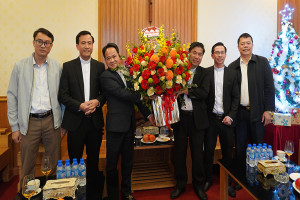
Trấn Quốc Temple is located in a small island near the southeastern shore of West Lake, Hanoi. It looks like a green island reflecting in West Lake. It is recognized as scared temple that attracts many Buddhists to worship. The history of this temple connects closely with national history and Buddhism in Thang Long – Ha Noi
Trấn Quốc temple was built 1500 years ago. It is the oldest temple in Thăng Long – Ha noi, it was considered as the central of Buddhism in the Ly – Tran dynasty, it is the bloom lotus in the spiritual realm
According to the Cultural Relics Dictionary of Vietnam (Hanoi, 1993) Trấn Quốc temple was built during the reign of King Lý Nam Đế (544 - 548), it had the name Khai Quốc (it means national founding) and located on Yên Hoa bank of the Red River.
It was renamed An Quốc in the Đại Bảo era during the reign of King Lê Thái Tông. In 1615, during the reign of King Lê Trung Hưng, the river bank crumbed into, the people in Yên Hoa (afterwards renamed (Yên Phụ) ward moved the temple to Cá Vàng island, in West Lake, the present location. The temple was built on the old foundation of Thuy Hoa palace (in the Lý dynasty) and Han Nguyen palace (in the Trần dynasty). Then Cổ Ngư dyke was built to connect the dyke with Cá Vàng island.
In 1624, 1628, 1639, Trấn Quốc temple underwent restorations. Its major restoration was in the reign King Lê Thần Tông in 1639. This temple was larger than before. In 1639, the first laureate Nguyễn Xuân Chính wrote about this event on the stele which is extant in the temple.
The last restoration was in 2012 to celebrated 1000th Thang Long – Hanoi anniversary. This Temple was renamed many times, now it’s called Trấn Quốc temple
Remember true monks
Trấn Quốc temple was designed according to ancient Buddhist architecture, the structure of Temple consist of three buildings namely the front hall, the incense burning hall and the upper altar.
Especially, in 1998, the 6-story Buddha’s throne was built on campus of temple corresponding to ancient temple which was built 15 centuries ago. Lục độ means six virtues. Six virtues are charity, discipline, patience, mediation, devotion and wisdom. Trấn Quốc temple is located on Cá Vàng Island, its right is Liên Đài tower (lotus throne). On the top of tower, there is a lotus. The Buddha’s throne was aspiration of Most Venerable Kim Cương Tử.

Most Venerable Kim Cương Tử started to manage Trấn Quốc Temple in 1982. At that time, he was deputy chief of Standing Committee of the Dharma Executive Council of Buddhism in Hanoi. He has been loved by monks and nuns, Buddhist followers. He had many contributions to Buddhism in Thang Long- Hanoi in particular and to the cause of developing Vietnam Buddhism in general. If we go into the temple, we see the body of Venerable that is preserved two story mausoleum near the 6 – story Buddha’s throne in Trấn Quốc temple . Although most Venerable Kim Cương Tử died, Vietnamese monks, nuns and Buddhist followers remember him, Trấn Quốc temple has gone down in history. Trấn Quốc temple is considered as a cultural heritage of our nation and the beautiful landscape of the city.
Chinh Tam




